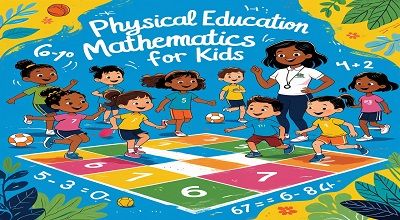Fun math games for PE class
Fun math games for PE class: Physical Education (PE) is a vital part of elementary school curricula, promoting physical health, teamwork, and motor skills. However, PE can also be an excellent opportunity to reinforce academic concepts, particularly math. Integrating math into elementary PE creates a dynamic, engaging learning environment where students apply numerical skills in real-world, active scenarios.
This blog post explores creative and effective ways to blend math with PE, ensuring students stay active while strengthening their mathematical understanding. From counting and measurements to geometry and statistics, we’ll cover practical activities, benefits, and expert tips for seamless integration.
Why Integrate Math into Elementary PE?
1. Enhances Engagement and Motivation
Many students find math challenging in a traditional classroom setting. By incorporating math into PE, teachers can make learning more interactive and enjoyable, increasing student participation and motivation.
2. Reinforces Learning Through Movement
Kinesthetic learning (learning through movement) helps solidify abstract math concepts. When students physically experience math—such as counting jumps or measuring distances—they retain information better.
3. Promotes Cross-Curricular Connections
Integrating subjects helps students see the real-world applications of math. PE provides a natural setting for applying arithmetic, geometry, and data analysis in a fun, hands-on way.
4. Supports Different Learning Styles
Not all students thrive in a desk-bound learning environment. Combining math with PE caters to visual, auditory, and kinesthetic learners, ensuring inclusivity.
Practical Strategies for Integrating Math into PE
1. Counting and Basic Arithmetic
Activity Examples:
- Jump Rope Math: Students count jumps, skip-count by 2s, 5s, or 10s, or solve addition/subtraction problems between sets.
- Math Tag: Assign numbers to students. When tagged, they must solve a quick math problem (e.g., “What’s 7 + 3?”) to rejoin the game.
Benefits: Reinforces number sense and mental math skills.
2. Measurements and Geometry
Activity Examples:
- Long Jump Measurements: Students measure their jump distances in feet/inches or meters/centimeters, then compare results.
- Shape Scavenger Hunt: Use cones or hoops to form shapes (squares, triangles). Students run to the correct shape based on clues (“Find a shape with 4 equal sides!”).
Benefits: Teaches units of measurement and geometric properties.
3. Data Collection and Statistics
Activity Examples:
- Fitness Charts: Track weekly activity (e.g., laps run, basketball shots made) and create bar graphs or line plots.
- Class Averages: Calculate the class average for a specific exercise (e.g., sit-ups in 30 seconds).
Benefits: Introduces data analysis and graphing in a tangible way.
4. Time and Speed Calculations
Activity Examples:
- Timed Relays: Students race in teams, then calculate their average speed (distance ÷ time).
- Beat the Clock: Solve math problems before a timer runs out (e.g., “How many 8+6 before 30 seconds?”).
Benefits: Strengthens time management and problem-solving under pressure.
5. Fractions and Probability
Activity Examples:
- Fraction Basketball: Shoot 10 baskets—record made shots as a fraction (e.g., 7/10), then convert to a percentage.
- Dice Fitness: Roll dice to determine reps (e.g., “Do ½ of 12 jumping jacks”).
Benefits: Makes fractions and probability interactive and fun.
Tips for Successful Integration
- Start Simple – Begin with basic math concepts before progressing to more complex problems.
- Use Visual Aids – Numbered cones, charts, and flashcards help reinforce learning.
- Encourage Teamwork – Group activities foster collaboration and peer learning.
- Align with Curriculum – Ensure activities complement classroom math lessons.
- Assess Progress – Use quick quizzes or observation checklists to track understanding.
FAQs About Integrating Math into Elementary PE
1. How much time should be spent on math during PE?
Aim for short, 5-10 minute math-infused activities within a 30-45 minute PE session to keep the focus on physical activity.
2. What if students struggle with the math concepts?
Differentiate activities by difficulty level. For example, younger students can count jumps, while older students calculate averages.
3. Do I need special equipment?
No! Use existing PE equipment (cones, balls, jump ropes) and simple math tools (stopwatches, measuring tapes).
4. How can I assess learning in this format?
Use observational notes, quick exit tickets (“What’s 5 x 2?”), or student-created graphs to assess understanding.
5. Can this work for remote or hybrid learning?
Yes! Assign at-home activities like measuring room dimensions or tracking exercise reps with family members.
Conclusion
Integrating math into elementary PE is a win-win strategy: students stay active while reinforcing essential math skills in a dynamic, memorable way. By incorporating counting, measurements, data analysis, and geometry into physical activities, teachers can create a more engaging and effective learning experience.
